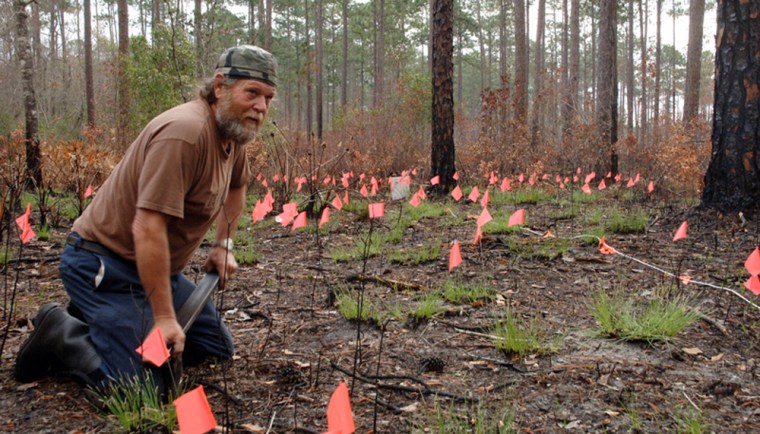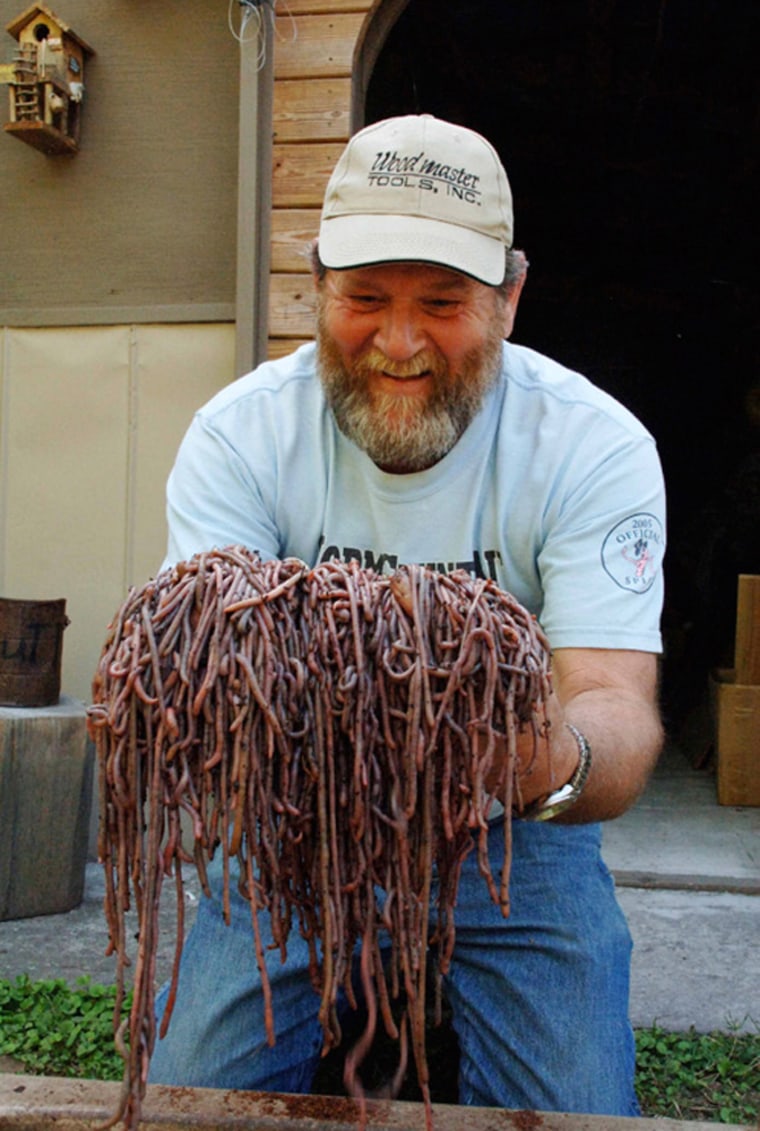Gary Revell gets up every morning before sunrise, heads into the woods and grunts. Not because it's so early. It's the term for coaxing worms from the ground by the hundreds to be scooped up and plopped in a tin can until he can sell them for fishing bait.
He pounds a two-foot wooden "stob" or stake into the earth and rubs it with a 10-pound piece of flat iron. The vibration or "grunting" causes worms to panic, and they wriggle from the ground. For years it was just a guess why.
Vanderbilt University biological sciences professor Ken Catania wanted to expand on a theory put forth by Charles Darwin that worms may sense moles are pursuing them if the ground trembles.
He joined Revell and his wife, Audrey, on a recent expedition and concluded that when Revell rubs the stob, worms do indeed sense that the predators are digging through the earth to eat them. The worms hightail it to the surface, only to be scooped up by Revell for fish food instead.
"Ken calls me the giant mole-man," Revell said with a laugh as he carried his equipment deep into Tate's Hell State Forest. "All I'm doing is mimicking the mole but in a larger scale, you know what I'm saying? That's how come they come up in a large area."
On a recent day, Revell, who has been scooping up worms for some 50 years, was out with two other grunters as the first light filtered through Tate's Hell. The only sounds were crickets chirping, woodpeckers pecking, birds singing and mosquitoes and horse flies buzzing — until Revell got to work.
The loud sound of metal pounding wood was followed by a steady, grunting rhythm as Revell got on his padded knees and began rubbing the stob. Almost immediately, worms starting to come up.
"They look good!" Revell yelled to his partners, clearly taking pride in his work. "Boy, that's pretty bait. Makes me want to go fishing."
For a good three yards around Revell, the ground was crawling and the other grunters were busy picking up worms.
"Oh yeah, it's magic," Revell said during a break. "There's an art to it. I've tried to teach people how to do it, and they just give up. You have to be really determined. It's got to be in your blood."
A ‘rare enemy’
Some of the "magic" might be that the sound of the stob's vibration is strikingly similar to a recording of a mole digging, Catania said. He stuck a microphone in the ground to record the noise the stob makes and also measured how fast worms crawled away after reaching the surface.

"It seemed like they were scared of something as they came up sort of rushing, for a worm, out of the ground," Catania said.
The Revells are what the worms would consider a "rare enemy," according to Cantania's study.
"Coming out of the ground is not the smartest thing for a worm to do," said Catania. "In some areas it's really hot and dry, and there's predators out there — we saw them get attacked by ants and snakes and lizards now and then. Why would they do that?"
He believes it's because for millions of years, moles have been eating worms, and they've developed an escape instinct when they sense the predators are burrowing nearby.
The Revells, whose main source of income is selling the worms he gathers, work the Apalachicola National Forest, which covers nearly 600,000 acres southwest of Tallahassee, and Tate's Hell, immediately to the south.
Before meeting the couple, Catania had never witnessed the practice.
"It's amazing to me, there's nothing like going to see it. I thought it was incredible," Catania said
A drop in the bucket
Later, while sipping iced tea at the Revells' home, he put a mole into a bucket filled with dirt and worms.
"It was amazing, man," Revell said. "When he dropped that mole in that bucket of worms, it was just like fear was in them. They come out of that ground, right out of that bucket. That pretty much let him know what he wanted to know about them. It was a predator/prey like thing."
Catania repeated the experiment under more controlled conditions, filling a container with dirt and a specific number of worms, waiting until they were all settled under the surface, and then letting a mole loose through a tube at the bottom of the container. The worms soon began fleeing out the top as fast as they could.
He also filled a much larger container with worms and ran a water sprinkler over it, simulating rain. The worms didn't rush out. That helped disprove the theory Revell has long had about why grunting works.
"This particular study was just wonderful because each little step made so much sense," Catania said. "It just all sort of fit together one piece after another all stemming from that original thought Darwin had."
